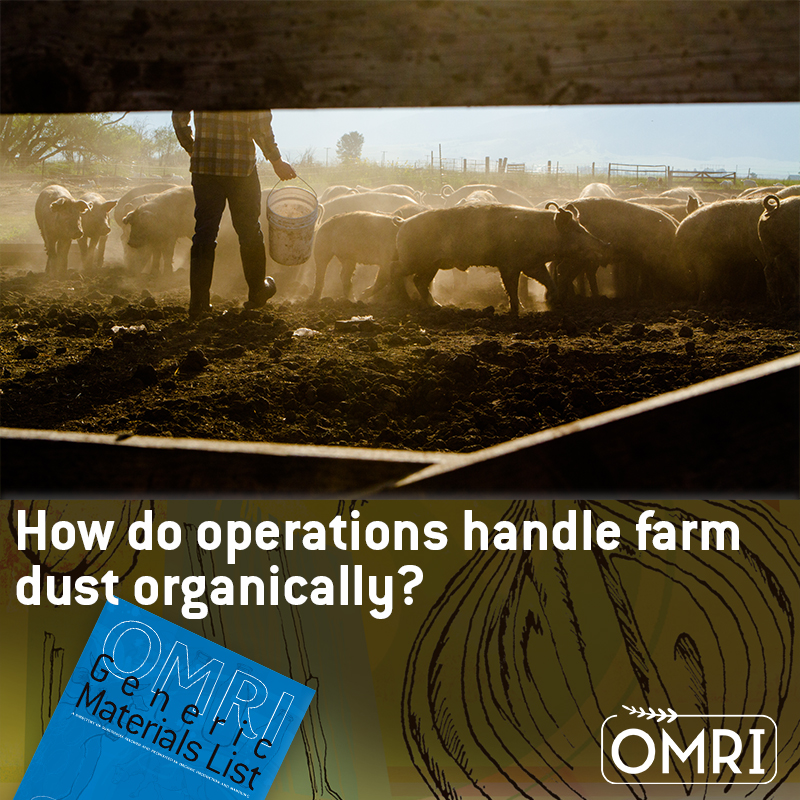Dust Control
 Why are dust suppressants important, and which materials are allowed for this use in organic production?
Why are dust suppressants important, and which materials are allowed for this use in organic production?
By Everett Codd
Dust emissions from agricultural operations contribute to air pollution and represent a serious health hazard for farmworkers and farm animals. On-farm dust can come from tillage practices, unpaved roads, the application of dry fertilizers, harvesting of grain, livestock, and any activities that displace soil. Many soil fertility and crop nutrient management practices required in the National Organic Program (NOP) regulations at §205.203 (a), (b), and (c) significantly help reduce dust emissions in organic production. In addition to these practices, a variety of dust suppressants are also used to control dust emissions. Examples of dust suppressants include water, hygroscopic materials (road salts), petroleum emulsion resins, polymers, surfactants, adhesives, and solid materials (petroleum by-products and soils). Of these examples, not all are compliant for organic use.
There are two general OMRI Generic Materials List© (GML) categories for dust suppressants, both in the use class Crop Management Tools and Production Aids (CT): Dust Suppressants, Nonsynthetic (Allowed) and Dust Suppressants, Synthetic (Prohibited). In general, these OMRI categories communicate the policy that nonsynthetic substances not listed on §205.602, and synthetic substances listed in §205.601 for this use are permitted. An adequate buffer zone is required between crops and any areas treated with prohibited dust suppressants, while water and nonsynthetic plant, mineral or animal-based materials may be allowed in production areas.
Hygroscopic salts (e.g., calcium chloride, magnesium chloride) are effective for dust suppression, but their use is limited in organic production. Magnesium chloride must be from a nonsynthetic mined source to be allowed for dust control in organic crop production. Nonsynthetic calcium chloride is restricted at §205.602(c) to use as a foliar spray for calcium deficiencies, and would not be allowed for dust control. Petroleum emulsions and polymer emulsions are commonly used on conventional farms and roadways, but they are prohibited for use as dust suppressants in organic production. Mulch and physical barriers are other possible inputs allowed in organic production, and are generally used in smaller scale applications.
The single allowed synthetic dust suppressant in organic crop production is lignin sulfonate, allowed at §205.601(j)(4). It has its own, separate OMRI category in the Crop Management Tools and Production Aids (CT) class: Lignin sulfonate, Synthetic (Allowed with Restrictions). Lignin sulfonate is a derivative of lignin, where the lignin has been sulfonated in a wood pulping process. It is typically used to reduce dust in the manufacture of granular fertilizers, and is widely used to control dust on unpaved roads. The lignin sulfonate salts sodium lignosulfonate, magnesium lignosulfonate, ammonium lignosulfonate and calcium lignosulfonate are specifically allowed as dust suppressants according to NOP regulations. Use of these lignin sulfonated salts for soil fertility purposes is prohibited. An additional OMRI standard is therefore applied to ammonium lignosulfonate. Specifically, ammonium lignosulfonate used according to §205.601(j)(4) may not contribute more than 1% nitrogen if used in a formulated crop fertilizer. Aluminum lignosulfonate is not allowed for use as a source of aluminum salts due to environmental contamination concerns, but it is not expressly prohibited as a dust suppressant. Sodium lignin does not meet the standard of identity for sodium lignosulfonate, and is considered a prohibited synthetic. Certified operations should contact their certifying agent regarding the use of any dust suppressants.
This article was originally published in the Fall 2017 edition of the OMRI Materials Review newsletter, and was re-reviewed in August 2019 by OMRI Technical Director Doug Currier.








